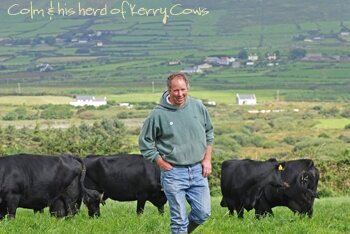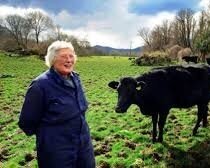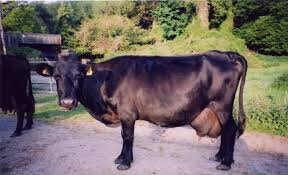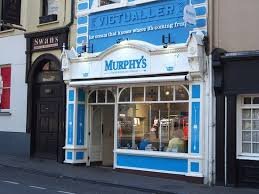A Hommage to the Kerry Cow – A Breed to Cherish
This article was triggered by the renewed interest in raw cows milk and also by discussions about the role of the cow in the current debate on climate change.
We had bought two Kerry Cows before we even set foot on this Island in August 1985. A German family who had made the move two years earlier and kept a small herd of Kerry cows had highly recommended them: “They are extremely hardy and can be outwintered. They are light on the land and do little damage to the pastures, because they are small. They live a long and healthy life and calf easily, but most importantly their milk is simply the best for making cheese, butter and yoghurt, and they are beautiful animals.” That sold it to us!
Our land was average to poor and we had no shed, but a burning ambition to be self-sufficient on dairy products from the very beginning, so keeping Kerry cows seemed to be a match made in heaven. On 15th October 1985 Glendalough Alice and Jane, pure bred Kerry cows, entered our lives and kept us company for almost 15 years, providing us with their tasty milk and building the foundation for our emerging organic farmhouse cheese enterprise.
Ireland’s Oldest Dairy Breed
The origin of the Kerry cow, now classified as a rare breed of cattle, dates as far back as 2000 BC. The Kerry cow is thought to have descended from the Celtic shorthorn, the little black cow, brought to Ireland by New Stone Age farmers, migrating from Eastern Europe seeking new land. “In ancient Irish society cows were of such overweening importance that they almost had a status as members of that society.” (Cattle in Ancient Ireland)
The Kerry cow’s job was always that of milk maker for smaller farms in the southwest of Ireland, specifically the “kingdom” of Kerry and Kerry cattle were first recognized as a breed in 1839 and the herd book was established in 1887. Ireland’s all year round mild climate favoured cattle for pasturing and dairying. “Our present day small black dairy cattle are the result of four and a half millennia of careful planning and selective breeding, thus making the Kerry probably the oldest dairy breeds in Europe.” writes The Kerry Cattle Society Ltd., who maintains the herd book, since taking over from the Royal Dublin Society in 2001.
The number of animals registered per year has fluctuated between 50 and 280 throughout the 20th century. To our knowledge there were a mere 250 in 1985 and talking to Mrs. Hilliard the secretary of the Kerry Cattle Society, researching for this article, we reckon there are probably 1000 registered Kerry cattle in Ireland, but only a very small number is utilised as a dairy cow. Like with many rare breeds, one of the reasons for the decline in numbers has been the displacement of Kerry cattle in favour of other breeds, such as Friesian and Holstein in Ireland.
Why are Kerry cows special?
A distinct characteristic of the breed is that the Kerry cow is small in stature, two thirds of the weight of a Holstein Friesian cow, making them light on the ground and perfect for keeping grazing land in good condition for longer. On average, a Kerry cow will produce about 3,000-3,700kg of milk in one season, one third compared to an average Holstein Friesian. What distinguishes the Kerry from every other breed is the health benefits of their milk, amongst the most nutritious milks in the world. The fat globules, being smaller than in other breeds makes the milk easier to digest for humans. The reason this cow produces such an amazing milk is that the breed has not been ‘improved’ by humans over time. It is milk as nature intended and makes the Kerry cow a very interesting proposition for anyone who prefers quality over quantity. In comparison, modern “improved” cows have been bred solely for producing large quantities of milk. The Kerry cow is a perfect example of how often less equals more and even the Slow Food Movement have also extolled the virtues of this humble animal.
Artisan Foods and Kerry cow milk
The taste also speaks for itself with high-end confectioners and artisan cheese makers choosing Kerry cow milk. The famous and award winning Gubbeen farmhouse cheeses utilise milk from Kerry cows.
Murphy’s ice cream makers in Dingle as well as Kells Bay Cheese get milk from Kerry cows milked by Colm Murphy in Lispole, Co, Kerry. Colm keeps 25 Kerry cows as part of his dairy herd ofFriesians and Holstein cows.
Seán and Kieran Murphy started Murphy’s Ice Cream in Dingle in 2000 with the goal of making the best ice cream in the world. On their website they state: “There’s no real trick to what we do, we just take care and use the best of everything. Murphy’s ice cream uses the milk from the rare, indigenous breed of Kerry cow because the milk is so wonderful.”
Kells Bay Cheese is a hard cheese matured to 12 months and 24 months old. They also use seaweed as an ingredient and won a silver medal at Blas 2020 for their 24 month old cheese with Dillisk. They have run trials using both Friesian Milk and Kerry cow milk separately for their cheese recipes, Brian Lynch tells me: "I find our cheese made with milk from the Kerry cow, using the same recipe, to have a much greater depth in taste development, has a deeper more buttery colour and has a more creamier taste feel in comparison to cheese made with milk from Friesian/Holstein cows."
What does the future hold for the Kerry cow?
“If the Kerry cow isn’t milked, she will die,” emphasises Mrs. Hilliard, who still milks 25 from a herd of 46. The milk goes to the Kerry Coop. There are some farmers who keep Kerry cows as part of a mixed herd to increase the butterfat content of their milk.
Brian from Kells Bay cheese has a plan too: “In time we would like to explore the possibilities of developing an upland dairy herd, maybe 15 to 20 cows on 60 to 70 acres of abandoned rough hill pasture here at Kells Bay. A very low input, out wintered, but well overseen, dairy herd based on the inherent merits of the Kerry Cow.” As he explored the concept in his thesis for a masters in organic farming, “the Kerry Cow Breed with this inherent ability to forage challenged semi natural pasture, refined through centuries spent in the uplands in this mountainous High Nature Value region in the Iveragh Peninsula, plays a vital role in the efficient intake of grass and its subsequent efficient conversion to milk and beef.”
The concept of High Nature Value (hnvlink.eu) farming developed in the early 1990s and according to Dr Caroline Sullivan such managed areas can “deliver much more than farmland biodiversity; they also deliver important ecosystem services such as clean water, good quality soils, flood and fire resilience, and contribute to vibrant rural communities.”(JCFJ - Environment 24/6/2020)
Our memories of Kerry cows will always be associated with our homemade quark which made the best delicious cheesecake, “a great provoker of gluttony amongst all those who encounter it”. (The Irish Food Guide by Sally & John McKenna, 1989)





